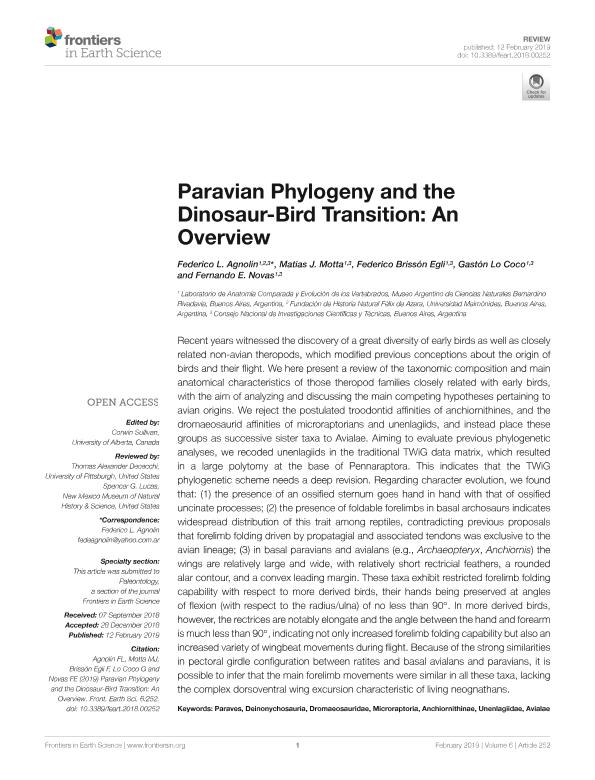Artículo
Paravian phylogeny and the dinosaur-bird transition: An overview
Agnolin, Federico ; Motta, Matias Javier
; Motta, Matias Javier ; Brissón Egli, Federico
; Brissón Egli, Federico ; Lo Coco, Gastón Ernesto
; Lo Coco, Gastón Ernesto ; Novas, Fernando Emilio
; Novas, Fernando Emilio
 ; Motta, Matias Javier
; Motta, Matias Javier ; Brissón Egli, Federico
; Brissón Egli, Federico ; Lo Coco, Gastón Ernesto
; Lo Coco, Gastón Ernesto ; Novas, Fernando Emilio
; Novas, Fernando Emilio
Fecha de publicación:
02/2019
Editorial:
Frontiers Media S.A.
Revista:
Frontiers in Earth Science
ISSN:
2296-6463
Idioma:
Inglés
Tipo de recurso:
Artículo publicado
Clasificación temática:
Resumen
Recent years witnessed the discovery of a great diversity of early birds as well as closely related non-avian theropods, which modified previous conceptions about the origin of birds and their flight. We here present a review of the taxonomic composition and main anatomical characteristics of those theropod families closely related with early birds, with the aim of analyzing and discussing the main competing hypotheses pertaining to avian origins. We reject the postulated troodontid affinities of anchiornithines, and the dromaeosaurid affinities of microraptorians and unenlagiids, and instead place these groups as successive sister taxa to Avialae. Aiming to evaluate previous phylogenetic analyses, we recoded unenlagiids in the traditional TWiG data matrix, which resulted in a large polytomy at the base of Pennaraptora. This indicates that the TWiG phylogenetic scheme needs a deep revision. Regarding character evolution, we found that: (1) the presence of an ossified sternum goes hand in hand with that of ossified uncinate processes; (2) the presence of foldable forelimbs in basal archosaurs indicates widespread distribution of this trait among reptiles, contradicting previous proposals that forelimb folding driven by propatagial and associated tendons was exclusive to the avian lineage; (3) in basal paravians and avialans (e.g., Archaeopteryx, Anchiornis) the wings are relatively large and wide, with relatively short rectricial feathers, a rounded alar contour, and a convex leading margin. These taxa exhibit restricted forelimb folding capability with respect to more derived birds, their hands being preserved at angles of flexion (with respect to the radius/ulna) of no less than 90°. In more derived birds, however, the rectrices are notably elongate and the angle between the hand and forearm is much less than 90°, indicating not only increased forelimb folding capability but also an increased variety of wingbeat movements during flight. Because of the strong similarities in pectoral girdle configuration between ratites and basal avialans and paravians, it is possible to infer that the main forelimb movements were similar in all these taxa, lacking the complex dorsoventral wing excursion characteristic of living neognathans.
Archivos asociados
Licencia
Identificadores
Colecciones
Articulos(MACNBR)
Articulos de MUSEO ARG.DE CS.NAT "BERNARDINO RIVADAVIA"
Articulos de MUSEO ARG.DE CS.NAT "BERNARDINO RIVADAVIA"
Citación
Agnolin, Federico; Motta, Matias Javier; Brissón Egli, Federico; Lo Coco, Gastón Ernesto; Novas, Fernando Emilio; Paravian phylogeny and the dinosaur-bird transition: An overview; Frontiers Media S.A.; Frontiers in Earth Science; 6; 2-2019; 1-28
Compartir
Altmétricas



